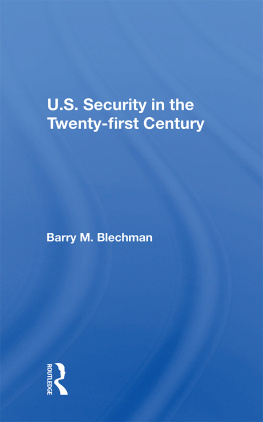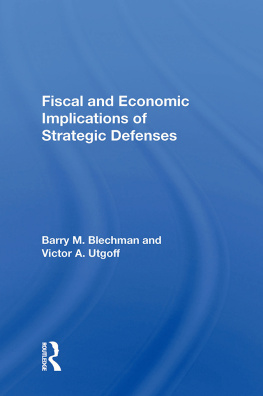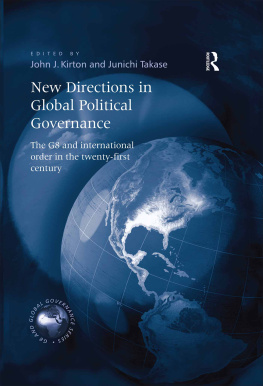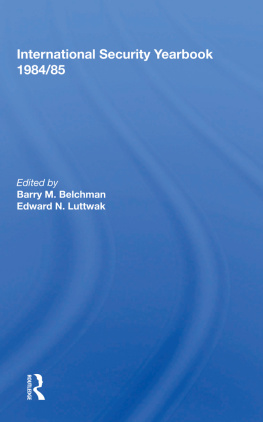U.S. Security in the Twenty-first Century
About the Book and Author
How will the international environment change, and what will be the shape of U.S. security policies twenty years from today? Barry Blechman answers these questions by analyzing the many variables that will influence the international arena. Some factorssuch as demographic trends--change slowly and can be forecast with confidence. Others depend more directly on often capricious changes in human attitudes and decisions and thus must incorporate greater degrees of caution. Dr. Blechman assesses such factors as demographic trends, patterns of economic growth, advances in military and civilian technologies, and--most important--shifts in national attitudes and relationships among nations that will influence the making of future U.S. security policies.
Utilizing Delphi techniques, in-depth interviews, and standard statistical projections of quantifiable factors, Dr. Blechman describes four plausible patterns in international relationships that would have very different impacts on U.S. security planning. He concludes that there is likely to be a continuing diffusion of international power, which will lead to reduced international cooperation, a further weakening of international institutions, more independent foreign policies, and more frequent recourse to military power. Even so, Dr. Blechman paints a relatively optimistic picture for the U.S., arguing that its overwhelming economic and technological prowess should enable it to maintain a relatively advantageous position throughout most of the world, well into the next century.
Barry M. Blechman is the founder and president of Defense Forecasts, Inc. He served as assistant director of the U.S. Arms Control and Disarmament Agency from 1977 to 1979 and has been affiliated with the Brookings Institution, the Carnegie Endowment, the Center for Strategic and International Studies, and the Johns Hopkins University Foreign Policy Institute. He prepared this study as a consultant for the Institute for Defense Analyses.
Preparation of this book was supported by a grant from the Central Research Program of the Institute for Defense Analyses
U.S. Security in the Twenty-first Century
Barry M. Blechman
First published 1987 by Westview Press, Inc.
Published 2018 by Routledge
52 Vanderbilt Avenue, New York, NY 10017
2 Park Square, Milton Park, Abingdon, Oxon OX14 4RN
Routledge is an imprint of the Taylor & Francis Group, an informa business
Copyright 1987 Taylor & Francis
All rights reserved. No part of this book may be reprinted or reproduced or utilised in any form or by any electronic, mechanical, or other means, now known or hereafter invented, including photocopying and recording, or in any information storage or retrieval system, without permission in writing from the publishers.
Notice:
Product or corporate names may be trademarks or registered trademarks, and are used only for identification and explanation without intent to infringe.
Library of Congress CataloginginPublication Data
Blechman, Barry M.
U.S. security in the twentyfirst century.
(Westview special studies in national security and
defense policy)
1. United States--National security. 2. Twenty-first
century--Forecasts. I. Title. II. Series.
UA23.B544 1987 355'.033073 86-18464
ISBN 13: 978-0-367-21236-0 (hbk)
To Jenny and Allison, who will see a lot more of the twenty-first century than I will; may your scenario be an optimistic one.
That future patterns of political/military relations are difficult to forecast is well known, of course, and is one consideration that discourages serious attention to long-range strategic planning. Given the considerable lead-times associated with the development and acquisition of contemporary weapon systems, however, deficiencies in long-range planning can have a serious, adverse impact on the nation's security. This study seeks to strengthen U.S. long-range military planning by identifying the major factors that will determine the strategic environment over the next twenty years, projecting their impact on relations in particular regions and between those regions and the United States, and combining these possible developments on a regional basis into alternative composite, strategic environments.
The author is grateful to Seymour Deitchman, vice president of IDA, who encouraged this book and ultimately made it possible. He also would like to thank his IDA colleagues, Phillip Gould, Robin Pirie, Paul Richanbach, William Schultis, Victor Utgoff, and Harry Williams, reviewers James Edgar, David-Jones, Thomas Moorer, and George Quester for helpful advice and guidance, and the nearly 100 experts listed in the report who contributed to the several parts of the analysis. The writer alone, of course, bears full responsibility for the content of the book.
William Y. Smith
President
Institute for Defense Analyses
1
Planning for the Year 2001
The standard window for long-range military planning--ten to twenty years--encompasses the turn of the century, a date that attracts far greater attention than most others, if only for symbolic reasons. What will the world be like as it enters the twenty-first century? What policies and objectives will the U.S. armed forces be asked to support? What challenges will be posed to U.S. security? Although the turn of the century seems very far away and events uncertain, in fact we can predict some things with confidence.
Demographic trends, for example, the size and distribution of the earth's population, can be forecast with near certainty. Birthrates in some countries may increase or, more likely, decrease and life expectancies may lengthen or shorten, but these changes will not have a significant impact for more than twenty years and, even so, are largely predictable. The distribution of the world's economic resources is also pretty well known; with only modest hesitancy we can forecast which nations will be the primary producers of energy, of critical minerals, and of food. It is not that existing patterns will not change--simply that the period of time required for new technologies to make possible the extraction of resources from new locations or to change the relative value of different types of resources is normally very long.
We also know a great deal about the structure and capabilities of the military forces that are likely to be operational in twenty years. This is certainly the case for such major items of equipment as warships, some of which require more than five years to build and have a life expectancy of more than thirty years. It takes five to seven years to design a new weapon, and even longer to develop one fully. Broadly speaking, the technologies that will determine the characteristics and capabilities of armed forces in twenty years are for the most part already known and already are being developed for military applications. In an age when both great powers relentlessly pursue potential military technologies in all scientific disciplines, technical surprises are a thing of the past.
In short, we can describe the physical parameters of the strategic environment at the turn of the century with a fair degree of accuracy. Inevitably, however, we are far more uncertain about events and relationships that depend primarily on human attitudes and decisions, this uncertainty is similar to the familiar intelligence dilemma of being able to discern capabilities but not intentions. It is far more difficult to make long-term predictions than short-term intelligence forecasts, moreover, because in twenty years capabilities themselves can be strongly influenced by intentions.












